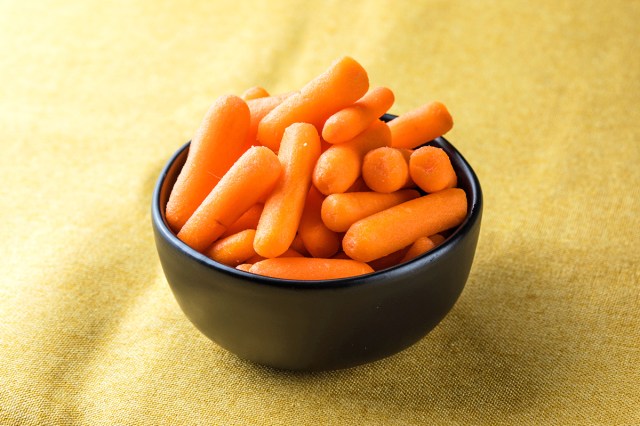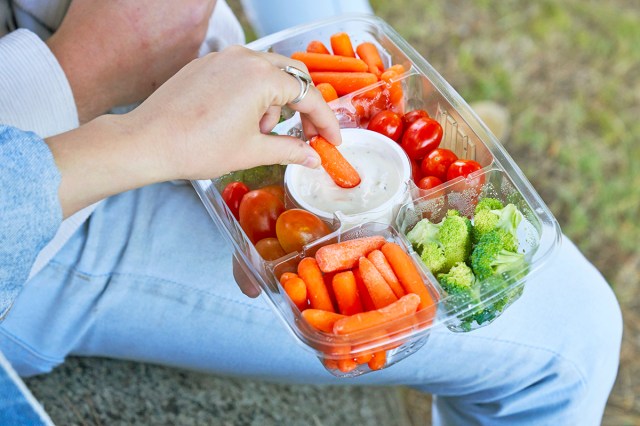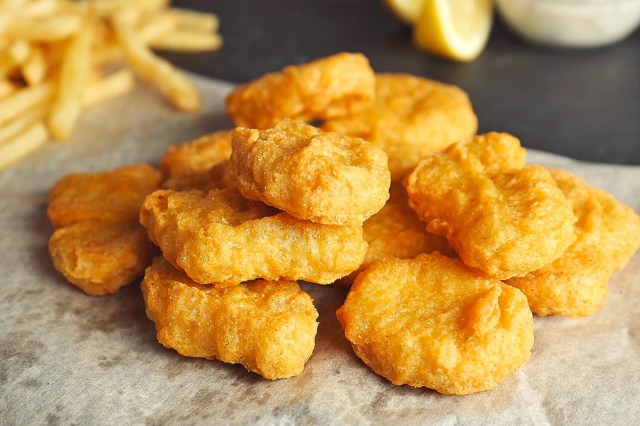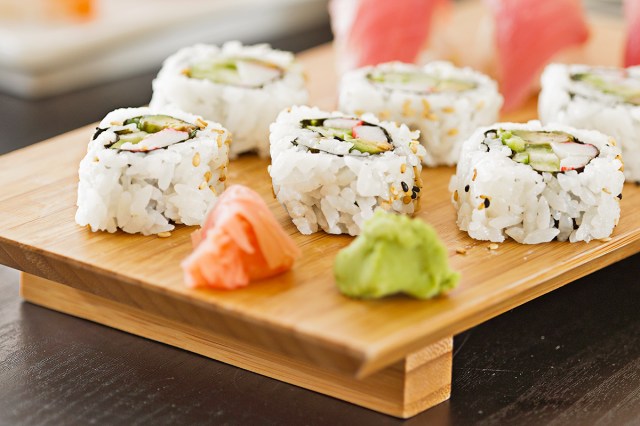
Baby Carrots
In the early 20th century, most Americans were pulling their own homegrown carrots out of the ground rather than buying bulk bags at the grocery store. And it wasn’t even possible to bring home a package of baby carrots, since those were actually an invention of the late 20th century.
In the late 1980s, California farmer Mike Yurosek contemplated the overwhelming waste of throwing out produce that didn’t meet acceptable grocery store aesthetic standards. To solve the problem, he started cutting and peeling irregularly shaped carrots into small, consistent pieces. He sent them to a local Los Angeles supermarket as a trial, and the rest, as they say, is history.
What started as a way to make use of imperfect produce soon became a popular product of its own. Baby carrots consistently outsell regular carrots in stores, and today there is specialized machinery to turn carrots into those bright orange, uniformly shaped snacks we’ve come to rely on.

Ranch Dressing
Ranch dressing is a staple condiment today, used both as a salad dressing and a dip for everything from vegetables to chicken wings to pizza crust. It’s hard to imagine a time before it existed, but this creamy, tangy dressing didn’t really take off until the 1980s.
It all began with Nebraska native Steve Henson. While working as a plumber in Anchorage, Alaska, in the early 1950s, he came up with the recipe — a mixture of buttermilk, mayonnaise, and various herbs and spices — while cooking for his work crew. In 1954, Henson and his wife, Gayle, moved their family to a 120-acre property near Santa Barbara, California, where they opened a guest ranch called — you guessed it — Hidden Valley Ranch.
Guests raved about the homemade dressing, and the Hensons began selling dry seasoning packets by mail so people could mix their own at home. In the early 1970s, the Clorox Company purchased the brand. A decade later, in 1983, the first bottled Hidden Valley Ranch appeared on grocery store shelves alongside the vinaigrettes and Thousand Island dressings that would have been familiar to those who grew up in the 1930s and ’40s. Today, ranch is the bestselling dressing in the United States.

Cup Noodles
For millions of college students, time-strapped professionals, and late-night snackers, few foods are as convenient as Cup Noodles. The instant ramen cups that can be prepared in minutes with nothing more than hot water feel like they’ve been around forever, but they didn’t actually hit U.S. shelves until the early 1970s.
Their story begins two decades earlier in postwar Japan, where food shortages inspired inventor Momofuku Ando to experiment with ways to make ramen quick and easy to prepare at home. In 1958, he introduced the result of his backyard-laboratory work: Chicken Ramen, the world’s first instant noodles. The convenience food took some time to catch on, but it eventually became a hit in Japan.
Cup Noodles (first sold as Cup O’ Noodles in the U.S.) arrived in America in 1973. The precooked ramen was sealed in a foam cup with dehydrated vegetables and flavoring that was ready to eat after adding boiling water. The packaging — pulling double duty as both container and serving bowl — has been found in pantries ever since.
More Interesting Reads

Chicken Nuggets
Now a fast-food and home-freezer staple, chicken nuggets are a surprisingly recent phenomenon. In the early 1960s, Cornell University food scientist Robert C. Baker developed a way to bind ground chicken meat into bite-size pieces that could be breaded and deep-fried without falling apart. It was one of many poultry recipes Baker and his graduate students developed in order to utilize more parts of the chicken, along with chicken hot dogs and cold cuts.
When McDonald’s introduced Chicken McNuggets in 1983, this practical invention turned into a pop-culture sensation. The company’s version inspired other chains and frozen food brands to follow, and the nugget became a mass-market mainstay.

Cool Whip
Cool Whip was a prominent mid-20th-century dessert staple, frequently seen mixed into fruit salads and dolloped on everything from Jell-O to pie. While the sweet retro snack may seem timeless, the fluffy topping didn’t appear until 1966.
Invented by food scientist William A. Mitchell at General Foods, Cool Whip largely became a hit because it could be easily shipped and stored around the country. That’s because, unlike homemade whipped cream, it wasn’t really made from dairy at all: Its signature airy texture instead came from a blend of water, oils, and corn syrup.
Marketed as modern and convenient, the product fit neatly into an era when refrigeration and convenience foods transformed the kitchen. Today, the recipe has been reformulated to include trace milk ingredients, including skim milk and light cream.

California Rolls
Sushi has been a staple of Japanese cuisine for centuries, but the California roll — the avocado, crab, and cucumber roll turned inside out — is a modern invention that helped make sushi mainstream in North America.
The precise origins of the roll are contested, but it’s most widely credited to two Japanese chefs in Vancouver, British Columbia and Los Angeles in the 1970s. Both claim to have adapted traditional sushi to appeal to local tastes: Real crab was often replaced with imitation crab, and avocado and mayonnaise added a creamy texture, while rolling the rice on the outside hid the nori for diners unfamiliar with seaweed. Today, the California roll is often one of the first sushi rolls Americans try, and it’s as common in convenience store coolers as on restaurant menus.












